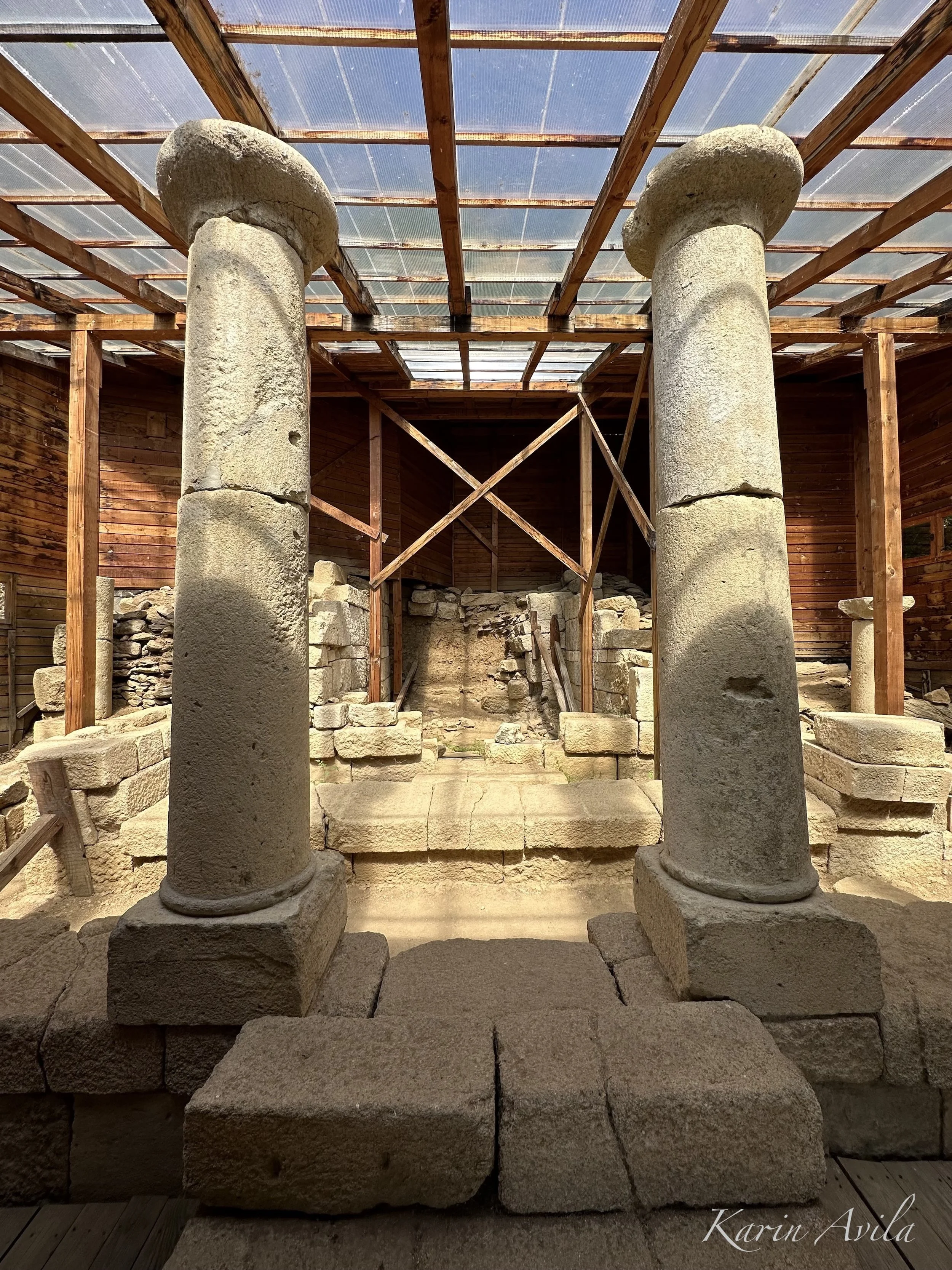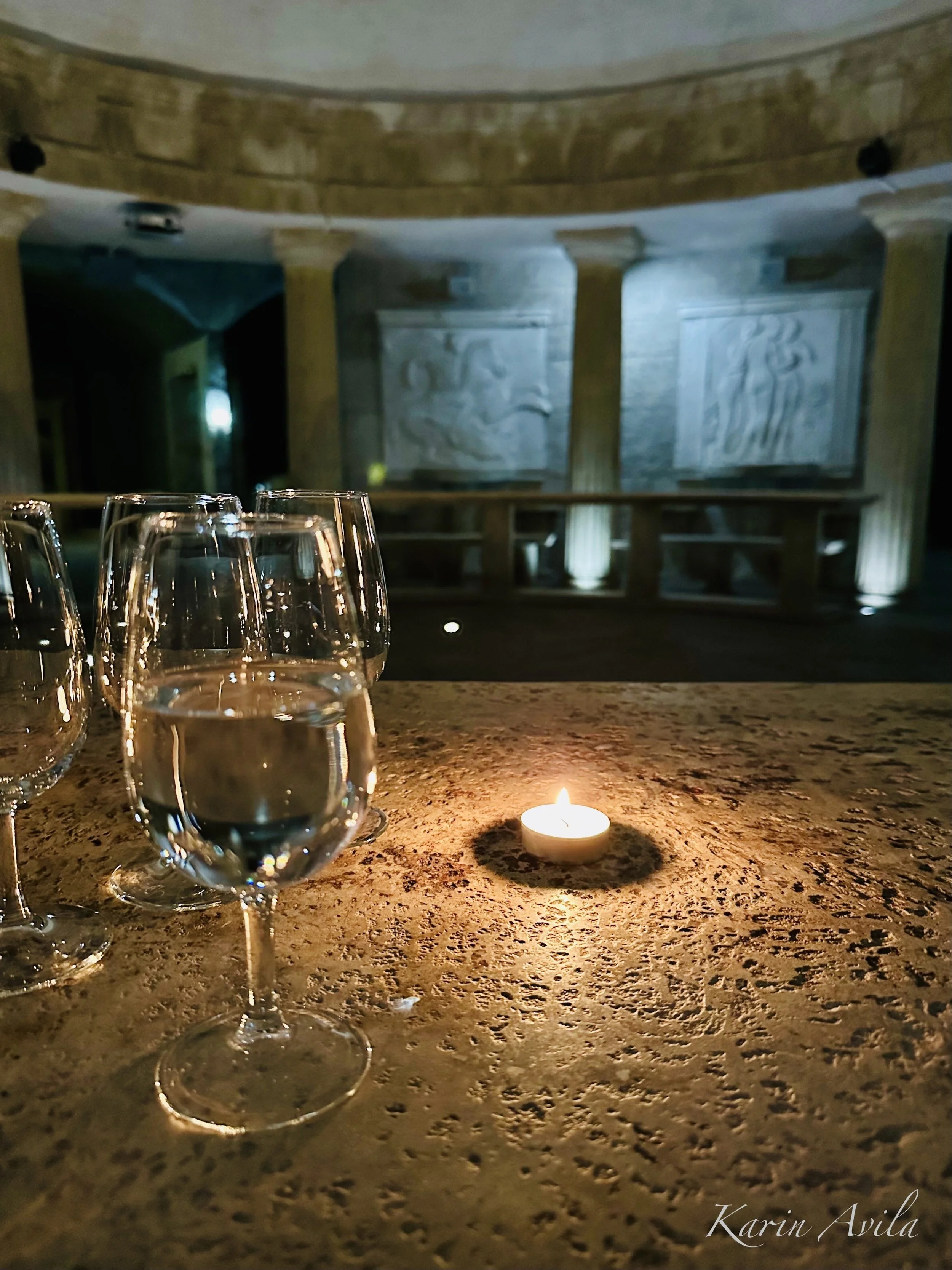The Cult of Wine
Starosel, Bulgaria
Plovdiv is surrounded by several appealing historic sites, perfect for a day or half-day trip. The region is a veritable history stew, rich with culture, architecture, and perhaps most exciting, vineyards – Bulgaria is one of the oldest wine growing regions in the world, dating back 7,000 years. There are various indigenous grape varieties that are still cultivated today, producing highly-regarded wines.
With only a week to spend in and around Plovdiv, it was difficult to decide which locale to select. Wanting to avoid tour groups, small or large, I decided to rely on public transportation when possible, which I felt would add depth to the experience. With historical ruins, day spa, and winery, Starosel offered everything I was looking for, and all within a few kilometers of each other.
View of nearby lake from Thracian temple near Starosel
Depending on the destination, public transportation from Plovdiv is limited in both routes and timetables, and schedules are not always predictable. With only one bus a day to and from Starosel, I opted for a hired car. This made this most sense, since the excursion would involve a few different stops off the beaten path from the nearby village.
The top historic attraction in Starosel is the Thracian Cult Temple Complex. The Thracians were warriors and inhabited Eastern Europe for centuries, establishing their first state in the 5th century BC. They were known for their superior fighting capability, and artifacts uncovered at historic sites revealed they were skilled craftsmen. According to historians, a lack of cohesion and in-fighting among Thracian tribes ultimately led to their demise; they disappeared around the 5th-6th centuries AD. Their legacy, however, is deposited all over Bulgaria, with several locations within easy reach of Plovdiv.
Wall built by Thracians, surrounding temple mound
The Starosel complex was discovery in the year 2000 and dates back to the 5th century BC. The structures are nestled into a picture-perfect countryside, feeling remote and removed from distractions. The discovery of the complex shed new light on this formidable and mysterious society; ceremonial temples, unique architecture, an ancient winery, and royal burial sites. The very structure is a wonder with multiple temples built into hill mounds, and walls built with large rectangular stone pieces. The complex is said to be the burial site of kings, and the temples used for worship after their deaths and to perform pagan ceremonies.
View from inside Thracian temple with unusual domes ceiling
Colonnades discovered at one of the burial sites are notable as the only structure of its kind associated with Thracian architecture. The modest-sized site was deemed of great significance, due in part to the colonnades and also to the silver, gold, and bronze pieces discovered.
The only known site with colonnade structures associated with Thracians
There is no better follow up to Thracian sightseeing than a good soak followed by wine tasting. Thracians are well-known to be lovers of making and imbibing wine. Unlike the Greeks and Romans, they consumed their wine pure and undiluted, which was considered barbaric and in poor taste at the time. Thracians started the cult of Dionysus, the god of wine, ecstasy, and madness, among other festive qualities, which the Greeks eventually adopted. Although their written history is scant, it seemed that in between ferocious battles, Thracians enjoyed drinking copious amounts of wine, creating music, and reciting poetry in a well-balanced, if not indulgent, lifestyle.
After contemplating the mystifying mound structures, it was time to head down the green and dreamy hills to Spa Hotel Starosel. The grounds were spacious, peaceful, and policed in flamboyant fashion by free-roaming peacocks. The spa facility was generous with hot tubs, saunas, a steam room, and a Roman-style bath area equipped with modern jets for easing muscular tension. A mineral water fountain punctuated the scene; tasting slightly of sulfur, there was a sign advising to let the water rest under the tongue for a few seconds before swallowing.
Preparing for tasting at Starosel Winery cellar
The day was rounded off with wine-tasting at the Starosel Winery, located on the grounds of the Spa Hotel Starosel. Competing against countless wineries throughout Bulgaria, Starosel produces some of the most popular and widely sold Bulgarian wines. The winery prides itself on integrating traditional methods into production in order to give the wines a warm and earthy finish. Although less than 20 years old, the wine cellar has the feel of a centuries-old Thracian temple, intentional by design, adding to the stirring ambiance.
In addition to Starosel, I had the honor of tasting wines from multiple regions in Bulgaria. I found the reds to be deep and rich, heavy with berry and hints of chocolate, and the whites, bright and floral. There are also rosés and orange, or amber, wines. Orange wines have been produced for thousands of years and are popular in Eastern Europe. The process involves leaving the skins of white grapes on the fruit, giving the final product an amber-like glow.
Variety of wines from Starosel Winery
Among its historical roots and valued traditions, Bulgaria has an impressive selection of wines that includes indigenous varieties. There is a banquet of styles to sample with enough diversity to entertain and occupy the palate for days.
Travel links
Plovdiv Trips for hired cars and group trips in and around Plovdiv: https://www.plovdivtrips.com/
Starosel spa and winery for day visits and overnights: https://www.starosel.com/en





